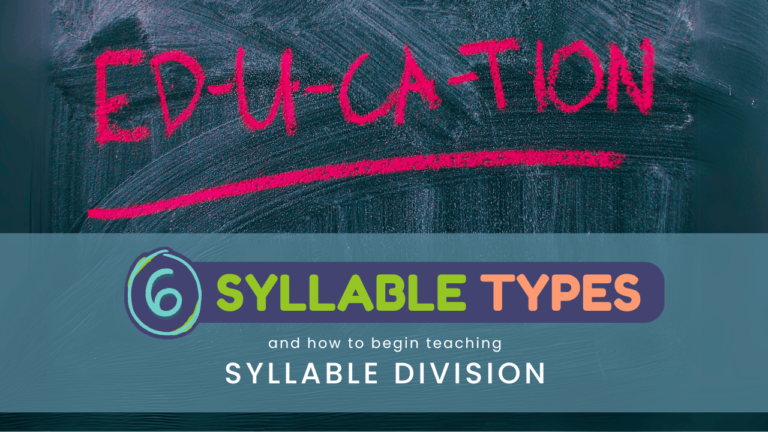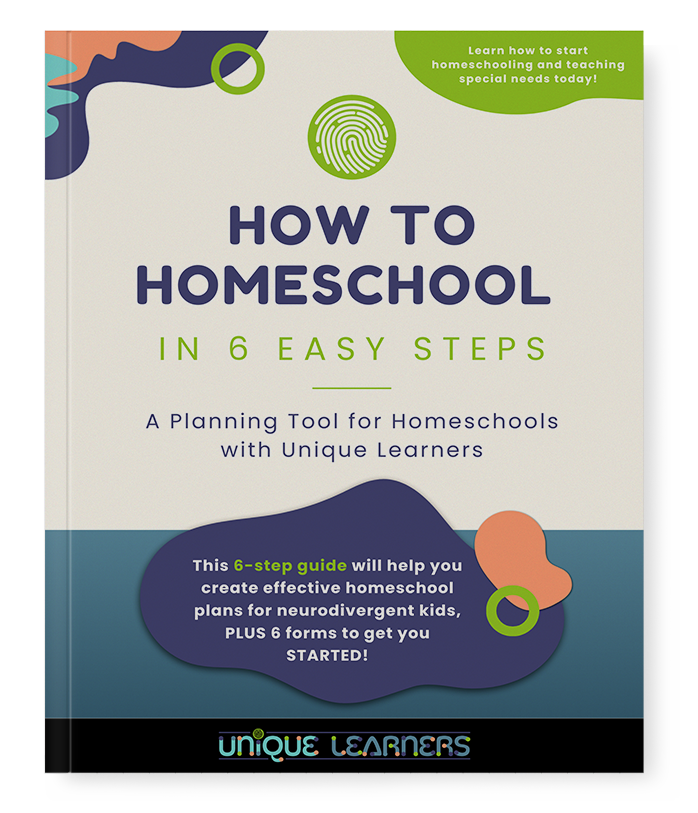Teaching systematic, multisensory phonics gets kids started in reading decoding and spelling. But as your student makes progress gaining fluency, many homeschool moms ask, “What next? How do I take my kids from sounding out one-syllable words to reading bigger words with syllable division?” The answer is to teach syllable types and rules next. Many kids, especially those who have dyslexia or other language-based learning struggles, cannot make the transition one their own to reading longer words with two and three syllables.

As I teach beginning reading, I introduce a specific sequence of letter sounds one at a time, with special emphasis on the individual short vowels. However, if an older student has already been taught the vowels to the point of confusion, I make sure the student is saying the sounds correctly and can segment and blend CVC words easily before moving on. It is essential to emphasize how important vowels are at every stage of learning to read and spell words.
Every word and every syllable in English has at least one vowel.
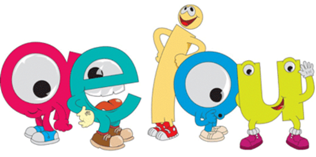
I combine movement cues with the short vowel sounds to help with distinguishing which vowel to use in spelling. Once a student can proficiently decode one syllable words with short vowels, I continue to expand to one-syllable words with silent e, open syllable words (like we, so, and my), r-controlled words, and vowel combinations. The specific sequence depends on which program I am using with a specific students. By the time we are ready to decode and spell multisyllable words, the student has a firm grasp on what vowel rules we look for. So, when it comes to teaching syllable division, the same vowel rules apply to bigger words. I have my students color-code the marks this way:
- Purple: Words are written on a white or cream-colored background
- Red: Underline the vowels, including vowel digraphs and diphthongs
- Blue Circle consonant blends, digraphs, affixes, and any other consonant combinations
- Green: Divide the syllables with a green vertical mark
Because nearly 50% of syllables in longer words are closed with short vowel sounds or an unaccented schwa sound, I emphasize the short vowels overly long so that the transfer from one syllable words to closed syllable longer words will help my students have success as soon as a new word is introduced.
What are the six syllable types?
So to get you started, here are the six syllable types, as well as the order that I teach them. Although the acronym to remember the syllable types spells CLOVER, I still teach them in this order: Closed, Silent E, Open, R-Controlled, Consonant+LE, and then Vowel Combinations last. By following this sequence, the rules are quite consistent and we can get much more reading and spelling vocabulary developed.
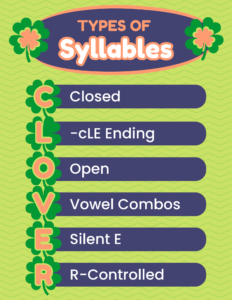
If you want this FREE poster for the Types of Syllables, click HERE.
I teach vowel combinations last because the “two vowel going walking” and the spelling patterns for each vowel sound can be very confusing for kids with dyslexia. The vowel combinations syllable rule can include regular combinations (ai, ea, and oa), vowel diphthongs (ou, oy, ow, au), as well as those out of the ordinary combinations where the syllable will split.
When I begin teaching syllables, I introduce the acronym CLOVER to let kids have an overview of what we will work on for syllable division and that there are only six syllable types.
Here are the cues that I have students recite aloud with me as we accomplish the splitting process.
C – Closed
“When a vowel is closed by a consonant door, it says its short sound.”
L – cLE
“L-E – before the before.” This means that we scoop the LE at the end, then scoop the consonant that comes before it. We divide the syllable before the consonant that comes before the LE.
O – Open
“When a vowel is left open, it says it’s own name. Is the vowel dangling at the end of the syllable?
V – Vowel Combinations
When two vowels are together, we have to make decisions.
“Do the vowels make a regular 2 vowels going walking combination, like ai, ea, oa, or others? Look at the poster if needed.” If the vowels are a regular combination, they follow the rule, so mark them with the red marker to show the syllable division.
“Do the vowels make a special rule, like oy, ow, au, or others? Look at the vowel poster if needed.” If the vowels are a special rule, circle them with a red marker to mark syllable division.
“Are the two vowels a different combination that we are used to seeing, like ia or io?” If so, we probably need to divide the syllable between the vowels!
E – Silent E
“Is there a silent e at the end of the word?” If e is at the end of a tiny word, it says its own name. If “e” is at the end of a long word, it is almost always silent. Slash it out with a red marker and decide if the vowel on the other side of the wall says its own name and mark it if needed. Sometimes in long words, the “e” is protecting a “v” from falling over and the vowel on the other side of the wall will still say its short sound. Slash out the “e” and mark the short vowel with a smile.
R – R-Controlled
Just as in one-syllable words, “r” is a robber. So when “r” comes after a vowel, we will circle the combination with a red marker for syllable division and decide if it says, /ar/, /or/, or /er/ because in longer words, any of the vowels can say /er/. We often will divide the syllable after the r-controlled rule.

Many long words just tack on a prefix or suffix, but we don’t worry about teaching morphology directly until dividing syllables has been mastered. If we are reading a passage with a word that has a prefix or suffix, I direct the student to circle that word part and just tell it to them with the encouragement that we will work on how really long words are assembled once we get through the six syllable types. That way the student knows there is a specific structure to the English language, and that support will be there all along the way. I have the student concentrate on how to divide the main root word with two or three syllables.
So…now that you know the six syllable types, here’s how to teach closed syllables!
I will only cover closed syllables because that needs to be the focus for quite awhile for our kids with language-based needs. Take your time. A few word samples to use right away are provided at the end of the directions.
The Teaching Steps for syllable types:
- For closed syllables I show a two syllable word and have the student copy the word. I typically write the word with purple marker.
- Then we recite the vowels: a, e, i, o, u, sometimes y. As we say the vowels, underline them with red marker.
- Next, we look between the vowels and draw a green vertical line between two consonants or after the one consonant for syllable division.
- Finally, we sound out each syllable as if the parts are nonsense words. Then blend each syllable together into the complete word.
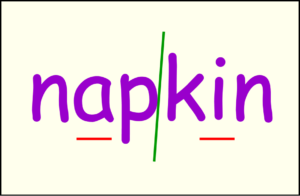
Some Sample Words:
napkin happen candid rabbit brisket lesson
Wisconsin fantastic badminton indignant
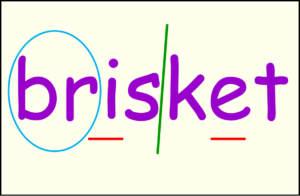
If you are looking for a curriculum to use in your homeschool, take a look at Explode the Code Book 4 for kids who need larger writing space or Megawords Book 1 for older students who have smaller handwriting. You can also find any of my vocabulary games and worksheets that help students practice syllable rules in the UL shop. Check out one of my best sellers, Cheery Checkers, HERE! If you want to see the other games for syllable rules, look in the Vocabulary/Spelling filter category.
If you have questions about teaching syllable division, feel free to email or message Sue Hegg at: uniquelearnersllc.com
Happy Reading and Spelling!
Sue
Grab your FREE e-book guide to revamp your homeschool for success!
Are you new to homeschooling, or just wanting a fresh start? Download our FREE “How to Homeschool in 6 Easy Steps” guide and get valuable insights from Sue’s 30+ years of experience as a special educator and homeschool mom of 4!
Want to know about new products and blogs?
Join our email newsletter to be the first to know about a new homeschool and special needs blog, and new products from our shop! Sign up for only the newsletter, or grab your FREE “How to Homeschool in 6 Easy Steps” guide and you will also be added to the newsletter!
Also, join our Facebook group!
Join our new “Homeschool Help for Special Needs” Facebook group! It is a place for homeschool moms to ask questions about homeschooling a child with special learning needs, share teaching and curriculum ideas that have worked (and those that bombed), and be real about the unique challenges of homeschooling with special needs. If you want to join us, be sure to answer the member questions to help us keep this private group secure. Join us now!
